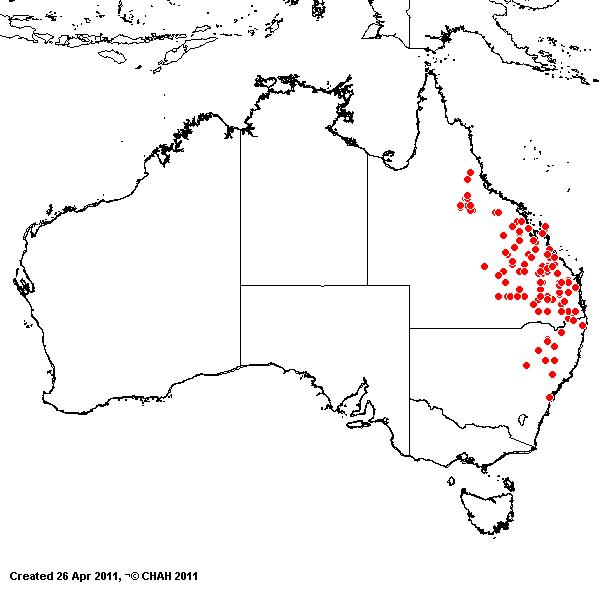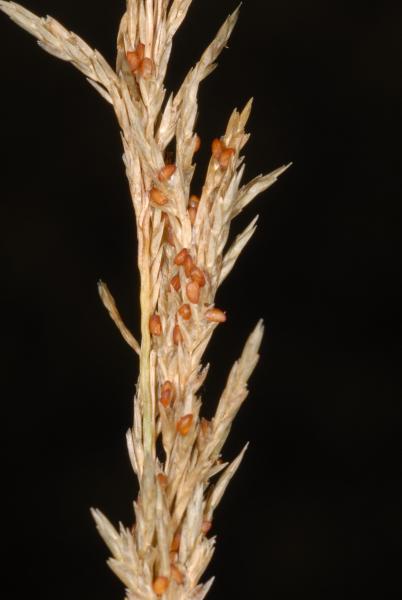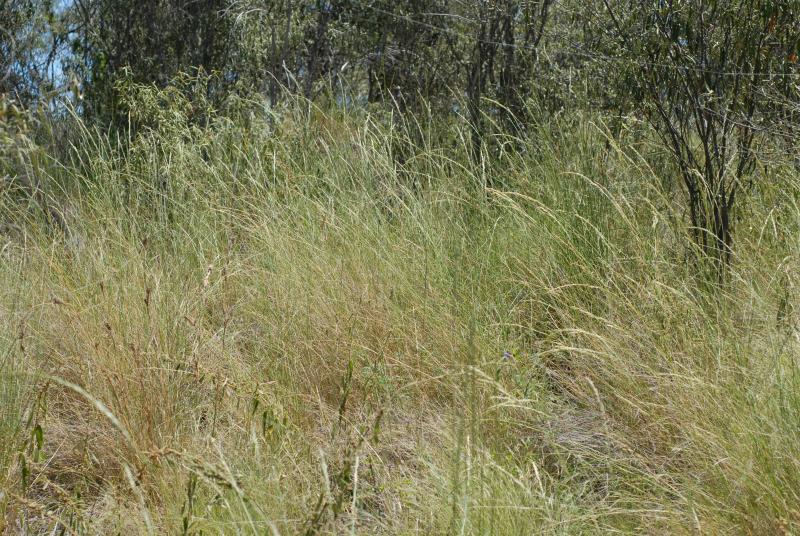Eragrostis megalosperma F.
Muell. ex Benth. Fl.
Austral. 7: 644
(1878).
Classification. (GPWG 2001) : Subfamily Chloridoideae.
Cynodonteae.
Type of Basionym or
Protologue Information: ST: O'Shanesy s.n., Australia: Queensland: Rockhampton
ST: Leichhardt s.n.,
Australia: Queensland:
Owydir River.
Key references
(books and floras): [1878] G.Bentham, Flora Australiensis 7 (644),
[2002] D.Sharp & B.K.Simon, AusGrass, Grasses of Australia, [2008]
S.W.L.Jacobs, R.D.B.Walley & D.J.B.Wheeler, Grasses of New South Wales
(254).
Illustrations:
[2005] K.Mallet (ed.), Flora of Australia 44B: Poaceae 3
(Fig. 68K-L), [2008] S.W.L.Jacobs, R.D.B.Whalley & D.J.B.Wheeler, Grasses
of New South Wales, 4th edn (254).
Habit.
Perennial. Rhizomes present. Culms erect, 60–120 cm tall. Lateral branches
simple or sparsely branched. Ligule a fringe of hairs, 0.2–0.4 mm long.
Leaf-blades straight, filiform or linear, flat or involute or convolute,
0.5–2.5 mm wide. Leaf-blade surface smooth, glabrous.
Inflorescence.
Inflorescence compound, a panicle. Panicle linear, 3–30 cm long, 0.7–2 cm wide.
Spikelets.
Spikelets pedicelled. Fertile spikelets many flowered, with at least 2 fertile
florets (5–27), comprising 5–27 fertile floret(s), with diminished florets at
the apex, linear or lanceolate, laterally compressed, 4–17 mm long.
Glumes. Glumes
similar. Lower glume lanceolate, membranous, keeled, 1-keeled, 1 -nerved. Upper
glume lanceolate, 1.1–2.5 mm long, membranous, keeled, 1-keeled, 1 -nerved.
Florets.
Fertile lemma 1.5–2.5 mm long, keeled, 1–3 -nerved. Lemma apex muticous.
Lodicules present. Anthers 3.
Continental
Distribution: Australasia.
Australian Distribution:
Queensland, New South Wales.
Queensland:
Burke, Burnett, Darling Downs, Leichhardt,
Maranoa, Moreton, North Kennedy, Port Curtis, South Kennedy, Warrego. New South Wales:
North-Western Slopes, North-Western Plains.
Notes.
Distinguishing characters include leaf sheaths longer than internodes; ligule
ciliate; panicle spiciform continuous; spikelets serrated in outline, often
olive-green; florets loosely imbricate, the lemma and palea divergent at
maturity; rachilla, glumes, lemmas and paleas persistent; glumes unequal,
separated by an internode at their points of attachment; lower and upper lemmas
in spikelet unequal in length, with often obscure or absent lateral nerves;
palea dividing into two equal parts, its keels almost smooth, and its flaps wider
than its body; anthers green, terminally exserted; caryopsis strongly
compressed, 3–4-angled, stipitate; pericarp free, mucilaginous, partly shedding
the polished, striate, naked grain.
Endemic;
distribution is in eastern Qld inland from Townsville S to near Inverell in
northern N.S.W. In deep or skeletal, often rocky, red or brown loams; in
association with sandstone gorges and ridges, basaltic outcrops, and limestone
boulders; also in disturbed clearings and roadsides.; flowers Dec.-July; fruits
Dec.-July.








